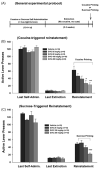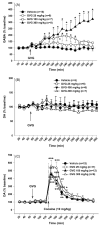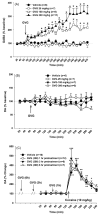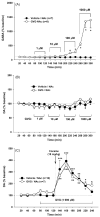Gamma-vinyl GABA inhibits cocaine-triggered reinstatement of drug-seeking behavior in rats by a non-dopaminergic mechanism
- PMID: 18063319
- PMCID: PMC2574671
- DOI: 10.1016/j.drugalcdep.2007.10.004
Gamma-vinyl GABA inhibits cocaine-triggered reinstatement of drug-seeking behavior in rats by a non-dopaminergic mechanism
Abstract
Relapse to drug use is a core feature of addiction. Previous studies demonstrate that gamma-vinyl GABA (GVG), an irreversible GABA transaminase inhibitor, attenuates the acute rewarding effects of cocaine and other addictive drugs. We here report that systemic administration of GVG (25-300 mg/kg) dose-dependently inhibits cocaine- or sucrose-induced reinstatement of reward-seeking behavior in rats. In vivo microdialysis data indicated that the same doses of GVG dose-dependently elevate extracellular GABA levels in the nucleus accumbens (NAc). However, GVG, when administered systemically or locally into the NAc, failed to inhibit either basal or cocaine-priming enhanced NAc dopamine in either naïve rats or cocaine extinction rats. These data suggest that: (1) GVG significantly inhibits cocaine- or sucrose-triggered reinstatement of reward-seeking behavior; and (2) a GABAergic-, but not dopaminergic-, dependent mechanism may underlie the antagonism by GVG of cocaine-triggered reinstatement of drug-seeking behavior, at least with respect to GVG's action on the NAc.
Conflict of interest statement
Figures





Similar articles
-
Cannabinoid CB1 receptor antagonist AM251 inhibits cocaine-primed relapse in rats: role of glutamate in the nucleus accumbens.J Neurosci. 2006 Aug 16;26(33):8531-6. doi: 10.1523/JNEUROSCI.0726-06.2006. J Neurosci. 2006. PMID: 16914679 Free PMC article.
-
Stereoselective inhibition of dopaminergic activity by gamma vinyl-GABA following a nicotine or cocaine challenge: a PET/microdialysis study.Life Sci. 2000 Feb 18;66(13):PL169-73. doi: 10.1016/s0024-3205(00)00432-x. Life Sci. 2000. PMID: 10737423
-
Inhibition of NAALADase by 2-PMPA attenuates cocaine-induced relapse in rats: a NAAG-mGluR2/3-mediated mechanism.J Neurochem. 2010 Jan;112(2):564-76. doi: 10.1111/j.1471-4159.2009.06478.x. Epub 2009 Nov 6. J Neurochem. 2010. PMID: 19895667 Free PMC article.
-
Gamma-vinyl GABA increases nonvesicular release of GABA and glutamate in the nucleus accumbens in rats via action on anion channels and GABA transporters.Psychopharmacology (Berl). 2010 Mar;208(4):511-9. doi: 10.1007/s00213-009-1753-7. Epub 2009 Dec 22. Psychopharmacology (Berl). 2010. PMID: 20033132 Free PMC article.
-
Metabotropic glutamate 7 (mGlu7) receptor: a target for medication development for the treatment of cocaine dependence.Neuropharmacology. 2013 Mar;66:12-23. doi: 10.1016/j.neuropharm.2012.04.010. Epub 2012 Apr 21. Neuropharmacology. 2013. PMID: 22546614 Free PMC article. Review.
Cited by
-
Substance Addiction Rehabilitation Drugs.Pharmaceuticals (Basel). 2024 May 10;17(5):615. doi: 10.3390/ph17050615. Pharmaceuticals (Basel). 2024. PMID: 38794185 Free PMC article. Review.
-
Hypothesis-driven medication discovery for the treatment of psychostimulant addiction.Curr Drug Abuse Rev. 2008 Nov;1(3):303-27. doi: 10.2174/1874473710801030303. Curr Drug Abuse Rev. 2008. PMID: 19430578 Free PMC article. Review.
-
The metabotropic glutamate receptor 7 (mGluR7) allosteric agonist AMN082 modulates nucleus accumbens GABA and glutamate, but not dopamine, in rats.Neuropharmacology. 2008 Mar;54(3):542-51. doi: 10.1016/j.neuropharm.2007.11.005. Epub 2007 Nov 19. Neuropharmacology. 2008. PMID: 18155073 Free PMC article.
-
The role of progestins in the behavioral effects of cocaine and other drugs of abuse: human and animal research.Neurosci Biobehav Rev. 2010 Nov;35(2):315-33. doi: 10.1016/j.neubiorev.2010.04.003. Epub 2010 Apr 14. Neurosci Biobehav Rev. 2010. PMID: 20398693 Free PMC article. Review.
-
The 2011 E. B. Hershberg award for important discoveries in medicinally active substances: (1S,3S)-3-amino-4-difluoromethylenyl-1-cyclopentanoic acid (CPP-115), a GABA aminotransferase inactivator and new treatment for drug addiction and infantile spasms.J Med Chem. 2012 Jan 26;55(2):567-75. doi: 10.1021/jm201650r. Epub 2012 Jan 10. J Med Chem. 2012. PMID: 22168767 Free PMC article. No abstract available.
References
-
- Anderson SM, Pierce RC. Cocaine-induced alterations in dopamine receptor signaling: implications for reinforcement and reinstatement. Pharmacol Ther. 2005;106:389–403. - PubMed
-
- Barrett AC, Negus SS, Mello NK, Caine SB. Effect of GABA agonists andGABA-A receptor modulators on cocaine- and food-maintained responding and cocaine discrimination in rats. J Pharmacol Exp Ther. 2005;315:858–871. - PubMed
-
- Bennett BD, Bolam JP. Synaptic input and output of parvalbumin-immunoreactive neurons in the neostriatum of the rat. Neuroscience. 1994;62:707–719. - PubMed
-
- Centonze D, Picconi B, Baunez C, Borrelli E, Pisani A, Bernardi G, Calabresi P. Cocaine and amphetamine depress striatal GABAergic synaptic transmission through D2 dopamine receptors. Neuropsychopharmacology. 2002;26:164–175. - PubMed
Publication types
MeSH terms
Substances
Grants and funding
LinkOut - more resources
Full Text Sources
Other Literature Sources

